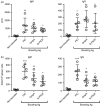Boosting of post-exposure human T-cell and B-cell recall responses in vivo by Burkholderia pseudomallei-related proteins
- PMID: 28066900
- PMCID: PMC5382348
- DOI: 10.1111/imm.12709
Boosting of post-exposure human T-cell and B-cell recall responses in vivo by Burkholderia pseudomallei-related proteins
Abstract
Burkholderia pseudomallei is the causative agent of melioidosis, an infectious disease with high incidence and mortality in South East Asia and northern Australia. To date there is no protective vaccine and antibiotic treatment is prolonged and not always effective. Most people living in endemic areas have been exposed to the bacteria and have developed some immunity, which may have helped to prevent disease. Here, we used a humanized mouse model (hu-PBL-SCID), reconstituted with human peripheral blood mononuclear cells from seropositive donors, to illustrate the potential of three known antigens (FliC, OmpA and N-PilO2) for boosting both T-cell and B-cell immune responses. All three antigens boosted the production of specific antibodies in vivo, and increased the number of antibody and interferon-γ-secreting cells, and induced antibody affinity maturation. Moreover, antigen-specific antibodies isolated from either seropositive individuals or boosted mice, were found to enhance phagocytosis and oxidative burst activities from human polymorphonuclear cells. Our study demonstrates that FliC, OmpA and N-PilO2 can stimulate human memory T and B cells and highlight the potential of the hu-PBL-SCID system for screening and evaluation of novel protein antigens for inclusion in future vaccine trials against melioidosis.
Keywords: B cell; T cell; antibodies; memory; neutrophil.
© 2017 John Wiley & Sons Ltd.
Figures







Similar articles
-
Novel multi-component vaccine approaches for Burkholderia pseudomallei.Clin Exp Immunol. 2019 May;196(2):178-188. doi: 10.1111/cei.13286. Epub 2019 Apr 8. Clin Exp Immunol. 2019. PMID: 30963550 Free PMC article. Review.
-
BpOmpW Antigen Stimulates the Necessary Protective T-Cell Responses Against Melioidosis.Front Immunol. 2021 Dec 13;12:767359. doi: 10.3389/fimmu.2021.767359. eCollection 2021. Front Immunol. 2021. PMID: 34966388 Free PMC article.
-
CD4+ T cell epitopes of FliC conserved between strains of Burkholderia: implications for vaccines against melioidosis and cepacia complex in cystic fibrosis.J Immunol. 2014 Dec 15;193(12):6041-9. doi: 10.4049/jimmunol.1402273. Epub 2014 Nov 12. J Immunol. 2014. PMID: 25392525 Free PMC article.
-
Immunization with the recombinant Burkholderia pseudomallei outer membrane protein Omp85 induces protective immunity in mice.Vaccine. 2010 Jul 12;28(31):5005-11. doi: 10.1016/j.vaccine.2010.05.022. Epub 2010 May 21. Vaccine. 2010. PMID: 20546831
-
Melioidosis vaccines.Expert Rev Vaccines. 2002 Dec;1(4):477-82. doi: 10.1586/14760584.1.4.477. Expert Rev Vaccines. 2002. PMID: 12901586 Review.
Cited by
-
Multicomponent Gold-Linked Glycoconjugate Vaccine Elicits Antigen-Specific Humoral and Mixed TH1-TH17 Immunity, Correlated with Increased Protection against Burkholderia pseudomallei.mBio. 2021 Jun 29;12(3):e0122721. doi: 10.1128/mBio.01227-21. Epub 2021 Jun 29. mBio. 2021. PMID: 34182777 Free PMC article.
-
Daily preventive zinc supplementation increases the antibody response against pathogenic Escherichia coli in children with zinc insufficiency: a randomised controlled trial.Sci Rep. 2022 Sep 27;12(1):16084. doi: 10.1038/s41598-022-20445-8. Sci Rep. 2022. PMID: 36167891 Free PMC article. Clinical Trial.
-
Novel multi-component vaccine approaches for Burkholderia pseudomallei.Clin Exp Immunol. 2019 May;196(2):178-188. doi: 10.1111/cei.13286. Epub 2019 Apr 8. Clin Exp Immunol. 2019. PMID: 30963550 Free PMC article. Review.
-
Immune Control of Burkholderia pseudomallei--Common, High-Frequency T-Cell Responses to a Broad Repertoire of Immunoprevalent Epitopes.Front Immunol. 2018 Mar 20;9:484. doi: 10.3389/fimmu.2018.00484. eCollection 2018. Front Immunol. 2018. PMID: 29616023 Free PMC article.
-
Metformin-induced suppression of IFN-α via mTORC1 signalling following seasonal vaccination is associated with impaired antibody responses in type 2 diabetes.Sci Rep. 2020 Feb 24;10(1):3229. doi: 10.1038/s41598-020-60213-0. Sci Rep. 2020. PMID: 32094377 Free PMC article.
References
-
- Currie BJ, Dance DA, Cheng AC. The global distribution of Burkholderia pseudomallei and melioidosis: an update. Trans R Soc Trop Med Hyg 2008; 102(Suppl 1):S1–4. - PubMed
Publication types
MeSH terms
Substances
LinkOut - more resources
Full Text Sources
Other Literature Sources
Molecular Biology Databases

